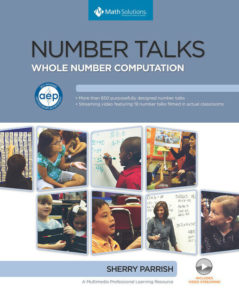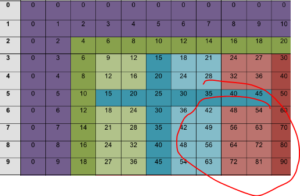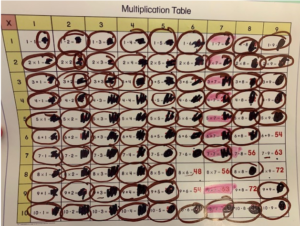
22 Mar They Don’t Know Their Facts! 3 Ways to Help.
Thomas Edison is notoriously quoted saying, “Insanity is doing the same thing over and over again and expecting a different result.” This logic applies to us when we are helping our students learn their math facts. Every year, we decide to use the same strategies but expect different results. It’s no surprise when we get the same results of students that still do not have a good grasp on their math facts and us, as teachers, frustrated that they do not know them.
In order to change these results, we need to change the way we approach teaching and reinforce multiplication facts with students. We need new strategies.
I have had a lot of time to reflect on this idea and see what really helps improve students’ multiplication facts. I have put together some of the most important do’s and don’ts of teaching math facts in the classroom that you can start implementing right away.
We’ll start off with the strategies that do not help your students learn their multiplication facts:
- Using and giving the same fluency test over and over again expecting different results, does not work. Remember that quote from Thomas Edison? This is a perfect example of how when we use the same strategy, we cannot expect different results.
Why it doesn’t work: Just quizzing students over and over again, will not improve their knowledge of their math facts. There must be a purposeful strategy in between each fluency test to really help students. This may look like using visuals, number talks, practicing counts bys (multiples), or making connections to strategies. Rehearsing facts to build automaticity is not inherently a bad thing, but doing so disconnected from strategy work makes it an ineffective strategy.
2. Shaming students because they do not know their math facts, does not work. Our choice of words is so important and means so much to our students. When we use language such as, “You still don’t know what 7 x 6 is? You should have known that already!” you’re only hurting your student. I understand because I have been there. I have been frustrated, using strategies that just don’t yield results.
Why it doesn’t work: It is very likely that the student is already aware they should have known these math facts. By reinforcing that to your student, you risk them shutting down and losing confidence in themselves which can further hinder them from continuing to learn their multiplication facts in the future. We actually know this for a fact because shaming a student puts pressure on their hippocampus, the working memory part of the brain, which in turn shuts down their ability to retrieve this information even if they did know it. (Beilock, 2011, Ramirez, et al, 2013)
3. Making the lack of knowledge of math facts the biggest issue when teaching a math skill, does not work. Sure, knowing the math facts makes it easier for the teacher and student, but we cannot continue making math facts the sole issue as to why other skills cannot be learned or taught. I am a firm believer that students who do not know their math facts can still do higher-level math.
Why it doesn’t work: There is more to math than mastery of facts. By letting go of the belief that this must be the basis for all math, you are able to understand that a math skill can still be taught without a student having mastery of all their facts.
4. Asking students to learn their facts at home does not work. There are 144 facts. We cannot expect a student to learn these facts without guidance or a strategy in place. Let alone, ask them to just go home and memorize them.
Why it doesn’t work: Without a strategy that is implemented in the classroom, a student cannot simply learn their facts by going over them again and again. Practicing all of the facts is not going to make a dent in fact mastery. This is not strategic practice and won’t yield the desired results.
If you have used or are using any of these practices in your classroom, it is okay. The truth is, this is probably how we were expected to learn our math facts when we were younger. I am here to tell you that you are able to support your students with strategies that actually do work and won’t cause frustration for you or your students. I promise that if you start looking at teaching mastery of math facts in the terms of the strategies you implement in your classroom, you can easily leave these other practices behind.
So, what does work?
- Know which math facts your students have mastered. It is important to understand that while you may want your students to know more math facts or feel they need to know more math facts, it does not mean they don’t know any at all. Your students have generally mastered most of their math facts, but there are a handful they do not yet know. Students usually have trouble with the 6, 7, 8, and 9 facts. Because of this, they may be the facts that are really getting in the way during math instruction. By knowing which facts your students know and don’t know, you can be more strategic during your instruction.
How to use this strategy:
Use a math chart to mark off the facts each student has mastered. Mark off the facts they know fluently (should take about 3-5 seconds). I take a sharpie and whiteout the answers to the ones they do know. This way, when they use the chart during class, it doesn’t become a crutch. They look the fact up, see it marked off and this signals to them that they know it. Then, I circle the ones they need help with. With this, the student can use their chart as the scaffold for long division lessons or whenever it may be needed.
On the Math Expressions chart, it says the problem next to the number. So, if you’re looking for 6 x 8, you will see 6 x 8 is 48, not just 48 as you do on other charts
Research shows that by the time students get to where they need to be, (let’s say 7 x7) and track it on the chart, they have already forgotten what the question was. So, using the multiplication chart wasn’t helping them learn their facts. Math Expressions has put the full equation in the box so students are reminded what the full fact is. You can grab your multiplication charts here.
By using this practice for you and your student to understand which facts they know, you can now be strategic about what they practice. You can let your students know that they need to practice their 6 times tables instead of telling them to practice all of them.
2. Be strategic during your instruction. Use your knowledge of the math facts your students don’t know to strategically implement those facts into your instruction and problem solving work.
How to use this strategy: Simply, change the factors when you need to support your students. If you are in the middle of a long division problem, and from the chart above, know that your student/s struggles with their 7’s, just change all the divisors to 7. Even if you change it for just one child, this will force them to practice their 7’s for each problem. Otherwise, for each new problem, they are having to recall an entirely new list of facts or multiples. In order to make progress, focus on one factor.
While they are learning something new, simplifying fractions or whatever you are working on, change all of the factors or divisors to facts they do know so they can learn the skill you are teaching. If we use our long division example, the steps alone to long division take an absurd amount of working memory. While learning how long division works, reduce the cognitive load and make the divisors numbers students are fluent in, such as 5’s or 2’s. Make new skills number-friendly so students will be successful. We can learn how to do long division or double-digit multiplication, or simplifying fractions. Those concepts can be learned without total mastery of facts. We can teach the skills using friendly numbers, and then once the skill is understood, apply to factors they do not know ( such as 7’s above).
In summary: use factors students don’t know when reviewing a skill, use factors students do know when introducing a new skill.
3. Create a classroom environment that allows for reasoning and sense-making. As mentioned earlier, shaming a student does nothing but harm them and their ability to learn or recall information. As a teacher, you have the power to impact your students with positive language shifts that will equip them with the confidence they need in order to learn their math facts.
How to use this strategy: Instead of saying, “Why don’t you know this?” shift it to, “What do you know?”
For example, if a student realizes they are solving a problem, but do not know their 6’s, I will ask them what they do know or which facts they are good at. The student may say they know their 5’s.
We can use this information to ask the student to then solve 5 x 7, which is 35. They can then simply add 7 to get 42.
Break it down to strategy work. This is when you would implement number talk (like the example provided). You can easily implement this during a lesson or as a warm up. Please do not feel the need to use this strategy every single time, but incorporating reasoning and strategy work tells a student that you value thinking over simply recalling. You also show them that no mathematics is impossible and they can use what they know to figure out a solution.
To incorporate this during your math warm-up, give students one problem.

Start by having your students show you two different ways they can solve this problem. Share and talk about the different ways and methods they came up with.
There should be no paper or pencil because students should come up with these methods in their heads.
A student may say they know their 10s. This is great. You can show them 6 x 10 = 60. They then know that there is one extra group of 6s, so you must subtract 6 for the answer. Be sure to write this down for your students.

Before you move on, have your students discuss each idea with their neighbors. This will help ensure that everyone understands how the idea can be used.
Be sure to use 2 different ways to use the number strategy. If we don’t make it explicit, kids don’t know how to do it. If teachers want kids to get better at multiplication, we MUST build in time for math talk, and specifically, number talks.
There are several books that may interest you in implementing number talks into your instruction. You can also get training from me!
This book is called, “Number Talks” by Sherry Perish. It comes with a DVD that gives you videos on how each method works.

You can get your copy of “Number Talks” by Sherry Parrish. You can get your copy here.
I’ve also compiled a list of the most common and effective reasoning strategies here.
Let’s be strategic about the ways we are tackling our math facts in the classroom. We need to know what students know, use friendly numbers when we introduce a new topic and create a climate of strategy/reasoning. This climate MUST be “It’s ok to not know, it’s not ok to stay there.”




Sorry, the comment form is closed at this time.